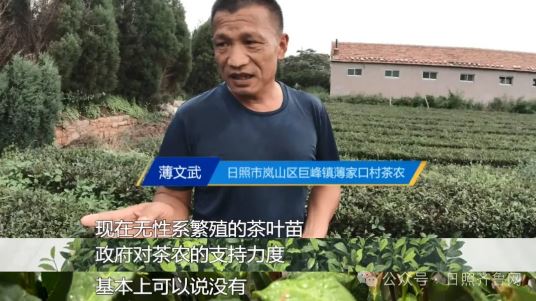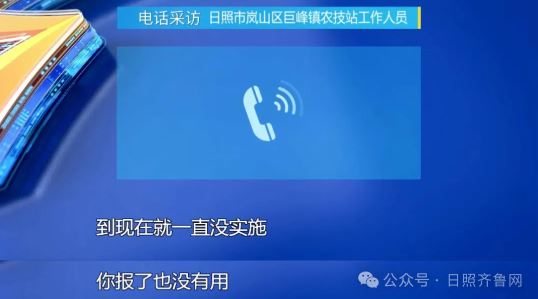At 7 PM on August 8th, episode 175 of the “Questioning Governance in Shandong” program was live-streamed. This episode focused on “Creating New Advantages in Promoting Rural Revitalization.”
Rizhao green Tea is a distinctive advantageous agricultural industry in Rizhao City, also known as “The First Tea of the North,” renowned for its high fragrance, rich taste, thick leaves, and durability when brewed. To further strengthen and expand the special Green Tea industry of Rizhao, the Shandong Provincial Department of Agriculture and Rural Affairs led the formulation of the “Rizhao Green Tea Advantageous Special Industry Cultivation Plan (2025-2025).” However, during field investigations, reporters found some issues with the promotion of high-quality tea seedling varieties.
Jufeng Town in Lanshan District of Rizhao City is one of the main production areas of Rizhao green tea, with tea tree planting areas accounting for 26% of the city's total. Local tea farmers explained that there are two methods of tea tree cultivation: sexual propagation through seeds and asexual propagation. The fresh tea leaves from seed-propagated trees are generally harvested around late April or early May, while those from asexually propagated trees can be harvested as early as mid-April, approximately 20 days earlier. This earlier market entry significantly increases the price of the tea.

Tea farmers introduced that both cultivation methods yield about 100 pounds of fresh tea leaves per mu. Based on this yield, during the Spring Tea harvest season, tea trees propagated by seeds generate an average income of around 3,000 yuan per mu, while asexually propagated tea trees generate over 10,000 yuan per mu. Tea farmers informed reporters that before 2025, Rizhao City provided subsidies for planting asexually propagated tea seedlings, and Zhang Zhanzhan from Qianshanwang Village was one of the beneficiaries of these subsidies.
Zhang Zhanzhan, a tea farmer from Qianshanwang Village in Jufeng Town, Lanshan District of Rizhao City, told reporters: “When we planted them, the government subsidized 6,000 yuan per mu.”
To further promote the planting of asexually propagated tea trees, in 2025, Lanshan District of Rizhao City issued the “Opinions on Accelerating the Development of the Tea Industry (2025-2025),” which explicitly encourages the construction of high-quality asexually propagated tea gardens and provides a subsidy of 6,000 yuan per mu for gardens using locally propagated suitable asexual seedlings.
However, Bo Wenwu, a tea grower from Baojiakou Village in Jufeng Town, told reporters that since 2025, he has been replacing his tea seedlings annually with locally propagated Zhongcha 108 or Baihao Early asexually propagated tea seedlings but has never received any subsidies.
Bo Wenwu, a tea grower, stated: “Now, the investment for asexually propagated tea seedlings is too high, around 10,000 yuan per mu. One could say that there is no support from the government for tea farmers.”

Why can't tea farmers enjoy such good policies?
A staff member from the Tea Division of the Lanshan District Department of Agriculture and Rural Affairs in Rizhao City said: “You have to apply first. After your application, we have to apply to the finance department.”
In response to the reporter's inquiries about the lack of subsidies in recent years, the staff member indicated that no one had applied.
However, during investigations in several village committees in Jufeng Town, reporters learned that previously, when tea farmers applied for subsidies, they did not do so individually at the Department of Agriculture and Rural Affairs but rather through notifications issued by the town government to the village committees, followed by applications made by the tea farmers to their respective village committees.
Regarding the issues of policy dissemination and subsidy implementation, reporters consulted relevant departments in Jufeng Town.
A staff member from the Agricultural Technology Station in Jufeng Town, Lanshan District of Rizhao City, stated that the document from 2025 has not been implemented to date.

In response to the situations reflected in the program, Ma Zongguang, Secretary of the Party Leadership Group and Director of the Rizhao Municipal Department of Agriculture and Rural Affairs, said: “After the program, we will immediately contact the land resources department. If it meets the requirements of relevant land planning, we will supervise the relevant districts and counties to promptly implement the subsidy policy.”
Song Wenhua, Member of the Party Leadership Group and Deputy Director of the Shandong Provincial Department of Agriculture and Rural Affairs, said at the program tonight: “Currently, the development of the tea industry in Shandong faces issues such as slow variety updates and aging tea gardens. The provincial Department of Agriculture and Rural Affairs attaches great importance to this and has issued opinions to promote the high-quality development of the tea industry. In the next steps, we will: first, strengthen variety research and development, plan a nursery base in Rizhao, introduce around 1,000 high-quality seed resources from all over the country, and develop new varieties; second, reinforce demonstration leadership and plan to build a high-standard demonstration area in the cities of Linyi, Tai'an, and Rizhao; third, strengthen technical training, aiming to train 2,000 tea farmers each year, focusing on cultivation techniques, winter management, and the transformation of old tea gardens; fourth, increase policy support. In short, we aim to integrate various policy elements to accelerate the high-quality development of our tea industry.”
